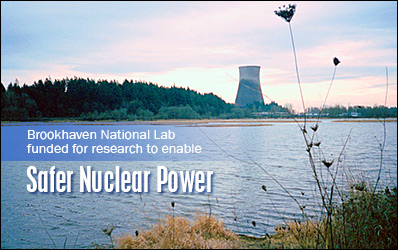Site Navigation
General Information
A New Approach for Solving Protein Structures
Recently, scientists from NSLS, the New York Structural Biology Center and Columbia University discovered a new method to determine molecular structures that would have been difficult or impossible to solve otherwise. More...
BNL’s Researchers Help Connect Nuclear Science and Nanoscience for Safer Reactors
Simerjeet Gill has been using the NSLS and the CFN to study radiation damage-tolerant nanocomposites, which may hold the key to solving problems of cracking, swelling and embrittlement in nuclear materials. More...
NIH Grants $1 Million Dollars for New Detectors at NSLS
New technology at the National Synchrotron Light Source will allow biologists to study proteins from a different perspective. More...
Brookhaven National Lab Funded for Research to Enable Safer Nuclear Power
Nick Simos of BNL’s Nuclear Sciences Department will be the principal investigator on a research project awarded $990,000 through the Department of Energy’s Nuclear Energy Enabling Technologies program, designed to enable cross-cutting research that will fundamentally improve the safety and performance of nuclear reactors. More...
For Scientists & Facility Users

As a national user research facility funded by the U.S. Department of Energy's Office of Science, the National Synchrotron Light Source (NSLS) offers scientists from academia, government labs, and other institutions exciting research possibilities in a wide variety of fields. Infrared, ultraviolet, and x-ray light produced by NSLS allow scientists to examine materials and processes at a scale that is not possible at other types of research labs or facilities.
The successor to NSLS, NSLS-II is scheduled to be operating by 2015 as the world's most advanced synchrotron light source. The new facility will have extremely high brightness and flux; exceptional beam stability; and a suite of advanced instruments, optics, and detectors. Taking advantage of these new capabilities, scientists will be able to image materials with nanoscale resolution and determine chemical activity in fine detail.
At NSLS, guest scientists can choose from a range of research techniques and equipment. As an NSLS (and future NSLS-II) user, you will discover that Brookhaven Lab's synchrotron facilities can provide the tools to perform cutting-edge research that is not possible at your home institution. You will also have the support of a well-trained staff.
Industrial Collaborators

GM's Joseph Ziegelbauer uses a potentiostat and galvanostat to test his electrochemical system in the new battery lab on the NSLS experimental floor.
The National Synchrotron Light Source (NSLS) and its future successor, NSLS-II, can help companies large and small solve research and manufacturing problems, generate new technologies and products, and stay competitive.
The Photon Sciences Directorate would like to encourage greater use of its facilities by industrial researchers and facilitate collaborations between industry and NSLS staff, as well as government and academic institutions.
For Educators

Teachers and students are welcome to experience science first hand at NSLS and NSLS-II. We work primarily in partnership with Brookhaven Lab's Office of Educational Programs, which coordinates programs aimed at boosting teachers' content knowledge and improving student achievement in science, technology, engineering, and mathematics (STEM). These programs help motivate and prepare all students, especially minorities and females, and address the serious under representation of minorities and females in STEM careers. A diverse workforce of scientists, engineers, and educators will help keep America at the forefront of innovation. More...
For Journalists

Exciting science is happening every day at NSLS, while construction moves ahead at NSLS-II. Journalists are invited to use the links below for the latest news and developments at both facilities. Please contact a Brookhaven media rep for more information and to arrange interviews.
What's a synchrotron?

The human eye can see only visible light. It comes in the form of different wavelengths. These wavelengths are what create the colors of the rainbow. Other wavelengths of lights are not visible to the human eye. Although, we cannot see them, these types of light are also used in our everyday life. For example, a TV remote control uses infrared light to adjust the volume or change the channel of the TV. Airport scanners use x-rays to scan luggage. Tanning lamps use ultraviolet light to tan the skin. Microwave ovens use microwaves to cook your food.
A synchrotron is a huge machine that produces very bright light of many different wavelengths. The light is much brighter than that found in your TV remote, microwave oven, or dentist's x-ray machine because the synchrotron beams of light are focused into very small spots. Think of a synchrotron as a giant microscope, allowing us to see matter at the atomic scale. More...
Announcements
Early NSLS Startup Planned
NSLS startup is planned a week earlier. The new schedule: VUV Ring startup Wednesday, 9/12, with operations beginning on Friday, 9/14, at noon; X-Ray Ring startup Thursday, 9/13, with operations beginning no later than Monday, 9/17, at 8 a.m. For current machine status, go here.
NSLS Proposals Due October 1
The NSLS General User proposal deadline is October 1, 2012, 5 p.m. eastern time, for the January-April 2013 cycle. To go directly to PASS, the proposal allocation system, click here.
Features
Next Lecture
NSLS-II Seminar
"Rock and Cell Workshop Day 1"
Monday, September 17, 2012, 8:30 am
Seminar Room, Bldg. 725
Show Details | Website | Save To My Calendar
Upcoming Workshops
Rock & Cell: From the Meso- to the Nanoscale with X-ray Spectromicroscopy
9/17/2012 - 9/18/2012
9/20/2012 - 9/23/2012







